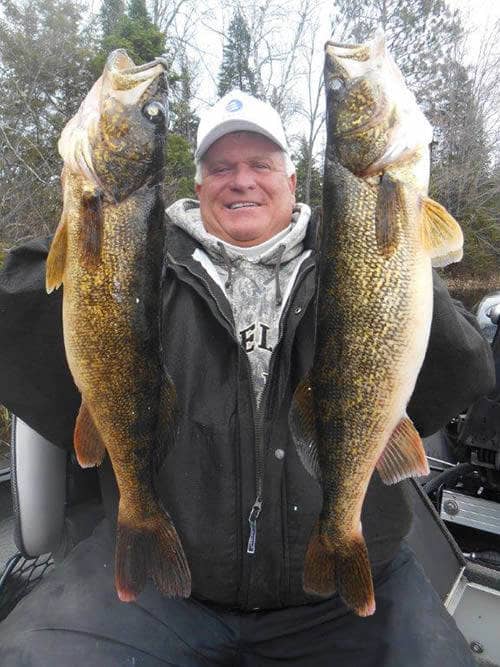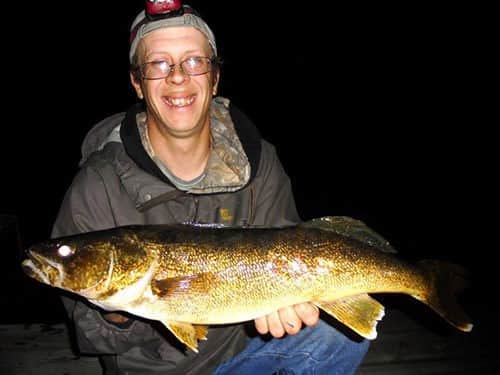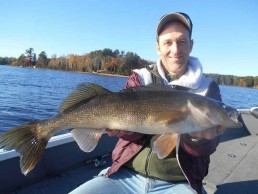Bucket List Walleyes: October/November – Prime Time for Trophies
SHARE THIS POST
by John Andrew, The Anglers Choice Guide Service
Do you want to catch a lot of walleyes? Right now is the time. Walleyes can be caught using several methods in the fall, so let’s go get ’em.
As water temperatures drop and many inland lakes experience fall turnover, walleyes go on the offensive, simply meaning that most of the walleyes (in many bodies of water) begin to feed aggressively in the middle of the day, in addition to the prime times of twilight and after dark.
Finding fall walleyes
Your sonar unit (depth finder) plays a huge role in finding fall walleyes. Think of the turnover as a huge turning point; after turnover is complete, walleyes can be at almost any depth, and are routinely found much deeper than other times of year.
Scout hard around:|
• rock humps, and ledges connected to rock humps;
• extensive underwater flats connected to shore, especially where they suddenly drop off into deeper water;
• drop-offs connected to main lake basins; and
• sides of drop-offs, whether gradual or steep ledges.
 On occasion, warm weather in October can find walleyes suspended over basins, and some walleyes lingering in shallow weeds.
On occasion, warm weather in October can find walleyes suspended over basins, and some walleyes lingering in shallow weeds.
Catching fall walleyes
Once we locate walleyes, I like to have my clients use a jig and minnow. With this presentation, we can drop baits directly into the school of fish and quickly find out how aggressive they are. If we catch a few walleyes, we stick with the jig and minnow. Drifting through the school while vertical jigging, then reeling up and moving the boat to drift over them again is very effective.
If we’re confident we’re over walleyes, but getting short strikes or catching only small fish, we switch to a crawler harness and backtroll through the walleyes very slowly. Sometimes called “trolling spinners,” this presentation is very effective, especially earlier in October, when water temps are just beginning to drop.
Trolling crankbaits is another great way to catch big fall walleyes. We have our best success, especially in early October, running crankbaits about 6 to 14 feet down, over weed edges and weedy drop-offs.
It can be important to “match the hatch,” because on several lakes in the northern Wisconsin, Minnesota, and the Dakotas, there is a fall migration of perch. The perch move into mid-depth weedlines, and can stay there until falling water temps chase them into deeper water. Wherever the perch go, so go the walleyes.
Are you enjoying this post?
You can be among the first to get the latest info on where to go, what to use and how to use it!
Leeches have long been good walleye bait, and a jig-and-leech combo works well in fall. On glass-calm days, a slip-bobber rig baited with a leech, worked over deep humps and deep flats can be killer.
As we get to late October and even early November (where ice hasn’t formed yet), walleyes tend to relate to some of the deepest ledges, drop-offs, and edges of main lake basins. They might even settle into the basin, depending on how deep it is.
A note of interest: lakes containing lake trout seem to have relatively shallower walleyes. In deep, clear lakes with no lake trout, walleyes seem to go deeper.
During late fall, minnows have been our best bait. We can offer minnows on a jig, Lindy Rig, or other slip-weight system. Working slowly with live bait is important this time of year, because walleyes are moving a little slower due to the cold water temperatures.
Sleeper spot
One spot gets almost no attention from your fellow walleye chasers, so you can usually have it to yourself: a necked-down area between two lakes, or a current area coming into a lake.
Cast artificial floating minnow baits in late fall, at night, and be stealthy about it. Big walleyes are skittish in skinny water, but if you approach them carefully and get baits where they are feeding, the results can be spectacular.
At late fall, also consider spending time on lakes that have whitefish and/or ciscoes. Trolling and casting along shore, where these important baitfish are spawning, can yield the fish of a lifetime. Use shallow-running minnow baits or crankbaits.
As elusive as big walleyes are, please realize that trophy fish are also vulnerable in the fall. Please keep only one big fish per person—or no big fish, as smaller ones are best for eating.
John Andrew is owner/operator of The Anglers Choice Guide Service in northern Wisconsin. He may be reached at 715-892-3020,
715-686-2012, or at: johnandrew@centurytel.net. Website: theanglerschoiceguideservice.com.
Did you enjoy this post?
You can be among the first to get the latest info on where to go, what to use and how to use it!

